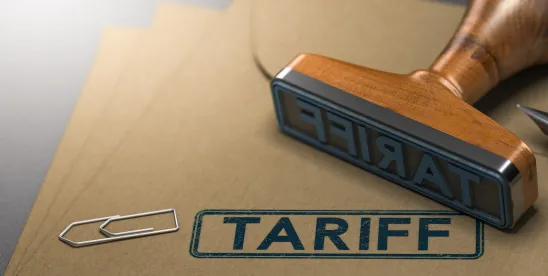Trump Administration Trade and Tariff Policies
- Foley & Lardner provided an update on the current Trump tariff proposals, as well as the implications of recent court decisions striking down tariffs issued under the International Emergency Economic Powers Act (IEEPA).
- President Trump on June 11 stated a trade agreement with China is “done, subject to final approval with President Xi and me.” The deal is said to include a framework for China to supply “any necessary magnets and rare earths.” [This breaking news story has frequent updates.]
- MEMA and a number of major automakers urged immediate action to address the risk of parts shortages and production disruptions resulting from policies in China that have restricted or delayed export licenses for certain rare earths, minerals and magnets.
- The European Association of Automotive Suppliers (CLEPA) on June 4 stated that “approximately one-quarter” of the rare earths export license applications submitted to Chinese authorities since April have been approved. Chinese exports of rare earths rose 23% in May from the previous month, according to customs data published June 9.
- President Trump signed an executive order to double Section 232 steel and aluminum tariffs to 50%, effective June 4. The governments of Canada, Mexico and Brazil are reported to be seeking exemptions to the steel import tariffs. Aluminum prices are projected to increase more than 20% to reach over $3,000 a ton by the end of 2026 due to the expectation of supply constraints and the effects of higher U.S. demand from Trump administration trade policies.
- The Office of the U.S. Trade Representative extended Section 301 tariff exclusions for certain products from China to August 31, 2025, from a previous expiration of May 31, 2025. The duties were originally implemented in 2018 and target products that include certain batteries, critical minerals, and semiconductors. The exemptions could be further extended or modified, per the notice.
Automotive Key Developments
- S&P Global Mobility and Automotive News provided overviews of the potential effects of higher steel and aluminum tariffs on automakers and suppliers. S&P noted the effects of various tariffs could cause U.S. new light-vehicle inventory to fall to 2 million units industrywide by this December, from current levels of roughly 2.7 million units.
- During a presentation at AutoTech 2025, S&P Global Mobility estimated automakers and suppliers are losing up to eighteen months of product planning due to the volatility of tariff policies.
- Predictions in Bank of America’s annual “Car Wars” report include ongoing multi-billion-dollar write-downs for EVs, an emphasis on “core” products to generate cash, and the potential for “mass consolidation” of the automotive industry in China resulting from extreme price wars and excess capacity. Automakers are expected to launch 159 models over the next four years, from typical levels of over 200, and the report noted the “next four+ years will be the most uncertain and volatile time in product strategy ever.”
- The Federal Communications Commission extended the public comment period by 18 days to June 27, 2025 on a proposal that could expand the list of vehicle connectivity technologies banned from Russian and Chinese manufacturers.
- The White House budget office instructed the Department of Transportation to disregard a Government Accountability Office decision that the DOT violated the Impoundment Control Act (ICA) by suspending the National Electric Vehicle Infrastructure (NEVI) Formula Program created by the 2021 Bipartisan Infrastructure Law. The ICA limits a president’s ability to hold back funds appropriated by Congress.
- Last week, sixteen states and the District of Columbia urged a Washington federal judge to grant their request for a preliminary injunction to stop the federal government from withholding NEVI funds.
- The DOT’s National Highway Traffic Safety Administration on June 6 published a final rule, Resetting the Corporate Average Fuel Economy Program, describing the agency’s legal foundation for its authority to revise CAFE and medium- and heavy-duty vehicle (MDHD) standards. An upcoming separate rule will revise the standards. This follows a proposal in the Senate’s pending tax and budget bill to eliminate fines for failures to meet CAFE rules.
- U.S. new light-vehicle sales in May increased 1.4% year-over-year to a SAAR of 15.6 million units.
OEMs/Suppliers
- As part of a $4 billion plan to increase U.S. manufacturing over the next two years, GM will expand finished vehicle production at Orion Assembly in Michigan, Fairfax Assembly in Kansas, and Spring Hill Manufacturing in Tennessee. This investment will support the ability to assemble up to two million vehicles annually in the U.S.
- Automakers shipped 72% fewer vehicles to the U.S. in May 2025 compared to the same period last year, according to maritime import data from Descartes Datamyne.
- Canadian exports of motor vehicles and parts fell 17% in April, according to data from Statistics Canada published on June 5.
- Aftermarket auto parts dealer Detroit Axle stated it could go out of business “within weeks” due to a Trump administration policy that ended the “de minimis” tariff exemption for small-value packages from China.
- A number of global suppliers are exploring opportunities to support Chinese automakers’ overseas expansions.
- The Chinese government is reported to have told the nation’s automakers to “self-regulate,” amid rising concerns the ongoing price wars among domestic EV makers could result in diminished profitability and significant industry consolidation.
Market Trends and Regulatory
- Kelley Blue Book estimated the average new-vehicle transaction price (ATP) in May 2025 was $48,799, largely flat with the April ATP but up 1% YOY. The average manufacturer’s suggested retail price (MSRP) in May rose 2% YOY to $50,968.
- The auto industry is the most likely sector to experience financial distress this year, according to two-thirds of respondents in AlixPartners’ 20th Annual Turnaround and Transformation Survey.
- The National Association of Manufacturers Q2 2025 Manufacturers’ Outlook Survey found 55.4% of respondents reported a positive outlook for their companies, representing a nearly 15 percentage point drop from Q1 and the lowest level since Q2 of 2020.
- Eighty-three percent of CEOs across all industries expect a recession in the next 12 to 18 months, according to the Conference Board‘s CEO confidence index.
- The fire on the car carrier Morning Midas started on a deck containing electric vehicles. However, the cause of the incident has not been confirmed. This marked the third serious fire in 2025 and the thirteenth in the past decade on “large ro-ro type ships.”
Autonomous Technologies and Vehicle Software
- Tesla could debut robotaxi rides in limited parts of Austin, Texas in the coming weeks.
- Alphabet unit Waymo has achieved 10 million paid driverless rides on a cumulative basis, and it books an average of over 250,000 weekly rides. The autonomous driving company offers paid rides in parts of San Francisco, Los Angeles, and Phoenix, and the company recently expanded to Austin and Atlanta in partnership with Uber.
- Uber Technologies, Inc. and self-driving startup Wayve plan to launch public-road trials of Level 4 (L4) autonomous vehicles in London in spring 2026.
- Autonomous truck-driving software company Plus Automation plans to go public in the U.S. through a $1.2 billion merger with special-purpose acquisition company Churchill Capital Corp. The combined entity will operate as PlusAI.
- China is developing national safety requirements for driver-assistance systems.
Electric Vehicles and Low-Emissions Technology
- Ford stated its plan to produce EV batteries at a new plant in Marshall, Michigan would be at risk if Congress eliminates federal tax credits for clean energy.
- Automotive Energy Supply Corp. (AESC) halted construction of an EV batteryplant in South Carolina due to “policy and market uncertainty”
- The majority of workers at a Stellantis – Samsung SDI battery joint venture plant in Indiana signed cards to join the UAW.
- Lucid Group signed its third agreement for U.S.-processed graphite, in an effort to strengthen its domestic supply chain for EV batteries.
- The advertised ranges of many EVs can vary significantly from the number of miles covered during Consumer Reports’ tests of 30 EVs driven at a constant highway speed of 70 mph. Over half of the tested vehicles missed targets in the advertised range, by anywhere from one mile to up to 50 miles. However, some models exceeded range by two miles to 67 miles. Unlike gas-powered cars, EVs are typically less efficient on highways than in cities.
- A recent AAA survey of 1,128 consumers found only 16% of respondents were “very likely” or “likely” to purchase a fully electric vehicle as their next car, representing the lowest level since 2019.






 />i
/>i

